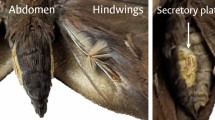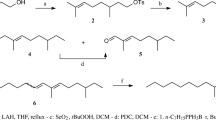Abstract
Paysandisia archon was accidentally introduced into Europe where it damages endemic and ornamental palms, also threatening the date palm from North Africa. Little was known about sex pheromones in the Castniidae day-flying moth before a recent paper that concluded on the absence of female sex pheromone in P. archon. A putative identification of a short-range male pheromone, present on fore- and hindwings, was reported. In this paper, we describe the original structure of the male androconia located on the tarsi of the mid-legs. The extracts of mid-legs were analysed by GC/MS and the chemical structure of the male androconia component was identified as E2,Z13-18:OH. After extraction in solvent, biological activity of the extracts was assessed by EAG. The chemistry and the morphology of the androconia reinforce the current classification of the Castniidae in the Cossoid/Sesioid assemblage and provide new information on the chemical ecology in day-flying Lepidoptera and suit the recent paper describing the courtship behaviour


Similar content being viewed by others
References
Beaudoin-Ollivier L, Frérot B (2006) Paysandisia archon: vous avez dit phéromone? Phytoma 594:30–32
Birch MC, Poppy GM, Baker TC (1990) Scents and eversible scent structures of male moths. Ann Rev Entomol 35:25–58
Blum MS (1987) Biosynthesis of arthropod exocrine compounds. Annu Rev Entomol 32:381–413
Boppré M (1978) Chemical communication, plant relationships, and mimicry in the evolution of Danaid butterflies. Entomol Exp Appl 24:264–277
Delle-Vedove R, Beaudoin-Ollivier L, Hossaert-McKey M, Frérot B (2012) Reproductive biology of the palm borer, Paysandisia archon (Lepidoptera: Castniidae). Eur. J. Entomol. 109:289–292
Delle-Vedove R, Frérot B, Hossaert-McKey M, Beaudoin-Ollivier L (2013) Courtship behavior of the Castniid palm borer Paysandisia archon: potential roles of male scents and visual cues in a day-flying moth. J Insect Sci (in press)
Edwards ED, Gentili P, Horak M, Kristensen NP, Nielsen ES (1999) The cossoid/sesioid assemblage, chap 11, pp 181–195. In: Kristensen NP (ed) Lepidoptera. (Encyclopedia of entomology J. Capinera; B. Heppner)
Gordh G, Headrick DH (2001) A dictionary of entomology. Cabi, Wallingford
Jordan K (1923) On the scent organs in the males of certain American Castniidae. Novit Zool 30:159–162
Lamas G (1995) A critical review of J. Y. Miller’s Checklist of the Neotropical Castniidae (Lepidoptera). Rev Peru Entomol 37:73–87
Lassance JM, Löfstedt C (2009) Concerted evolution of male and female display traits in the European corn borer, Ostrinia nubilalis. BMC Biol 7:10
Le Cerf F (1936) Un type remarquable d’androconie chez certaines Gazera Boisduval (Lep. Castniidae). Bul Soc Entomol Fr 41:191–195
Minet J (1991) Tentative reconstruction of the ditrysian phylogeny (Lepidoptera/Glossata). Entomol Scand 22:69–95
Nieberding CM, de Voss H, Schneider MV, Lassance JM, Estramil N, Andersson J, Bång J, Hedenström E, Löfstedt C, Brakefield PM (2008) The male sex pheromone of the butterfly Bicyclus anynana: towards an evolutionary analysis. PLoS ONE 3(e2751):1–12 (Public Library of Science)
Rebouças LMC, Do Caraciolo MSB, Sant’Ana AEG, Pickett JA, Wadhams LJ, Pow EM (1999) Composição química da glândula abdominal da fêmea da mariposa Castnia licus (Drury) (Lepidoptera:Castniidae): possíveis feromônios e precursores. Quím Nova 22:645–648
Sarto i Monteys V, Acin P, Rosell G, Quero C, Jiménez MA, Guerrero A (2012) Moths behaving like butterflies. Evolutionary loss of long range attractant pheromones in Castniid moths: a Paysandisia archon model PLoS ONE 7(1):1–11
Séguy E (1967) Dictionnaire des termes techniques d’entomologie élémentaire. Lechevalier, Paris
Zagatti P, Renou M (1984) Sex pheromones of Zygaenid moths. Mating behavior of the 6-spotted burnet moth Zygaena filipendulae (Lepidoptera Zygenidae). Ann Soc Entomol Fr 20:439–454
Acknowledgments
The project was funded by the “Région Languedoc-Roussillon and CIRAD” grant. We would like to thank the arborist, city of Montpellier, for providing infested palms.
Author information
Authors and Affiliations
Corresponding author
Rights and permissions
About this article
Cite this article
Frérot, B., Delle-Vedove, R., Beaudoin-Ollivier, L. et al. Fragrant legs in Paysandisia archon males (Lepidoptera, Castniidae). Chemoecology 23, 137–142 (2013). https://doi.org/10.1007/s00049-013-0128-z
Received:
Accepted:
Published:
Issue Date:
DOI: https://doi.org/10.1007/s00049-013-0128-z




